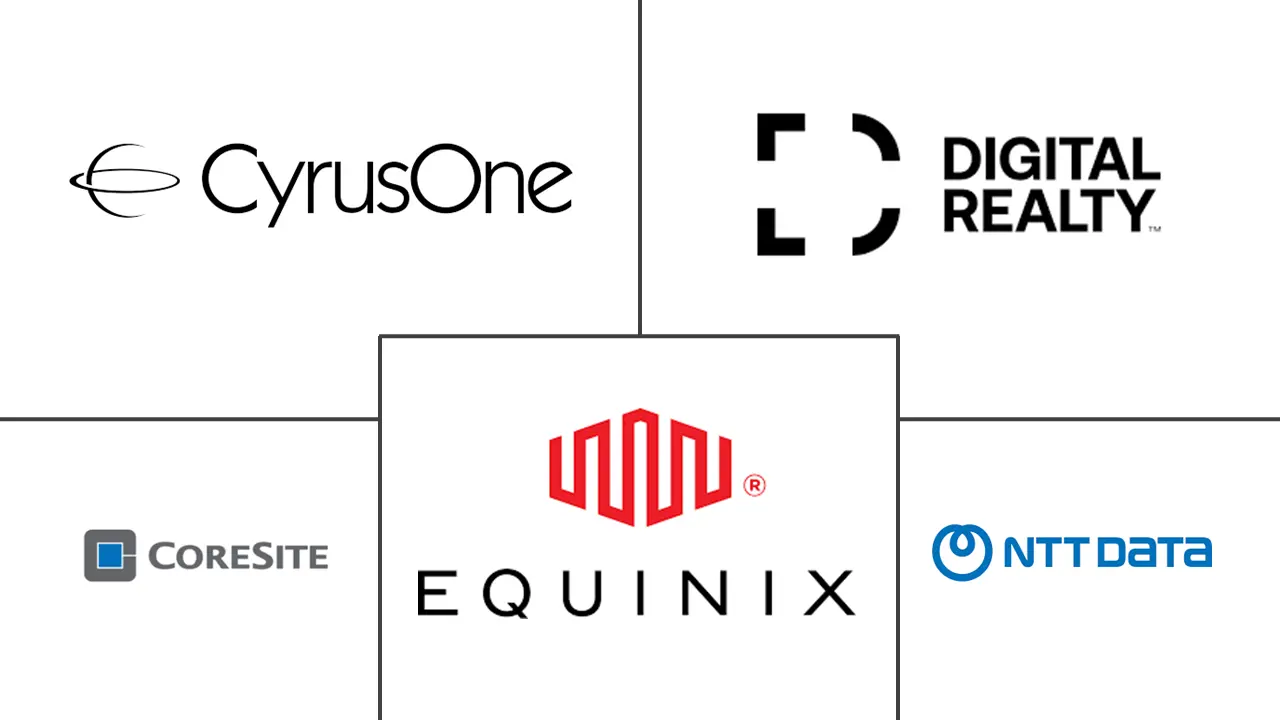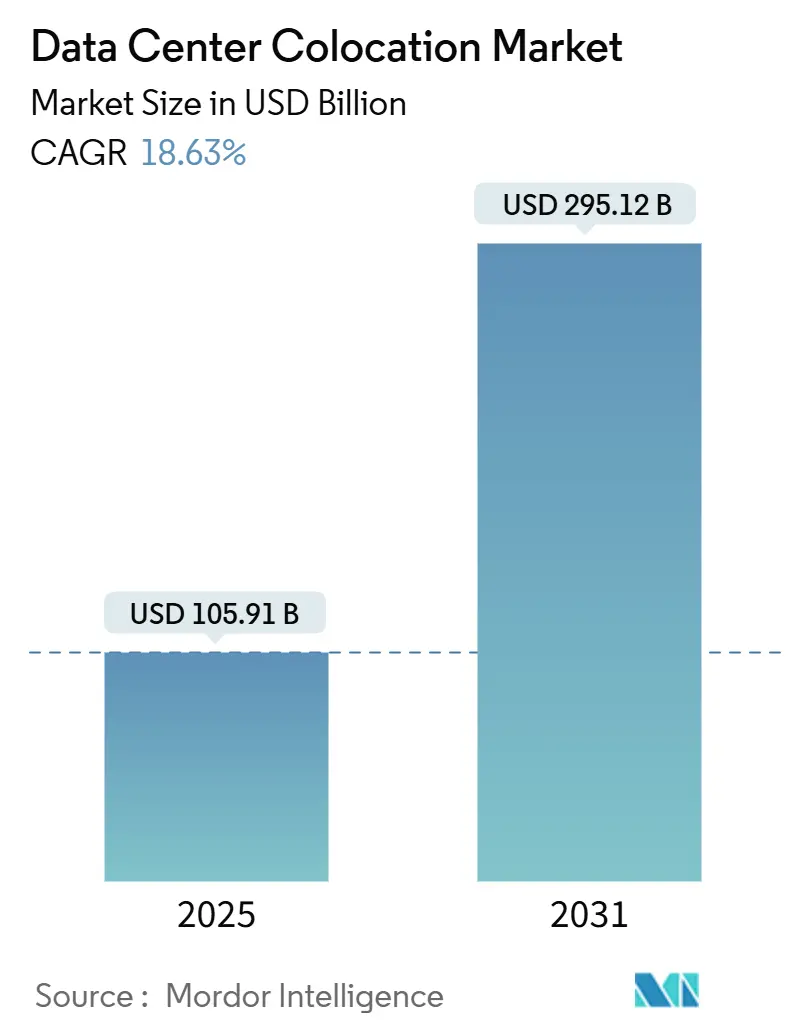
Data Center Colocation Market Analysis by Mordor Intelligence
The data center colocation market size is valued at USD 105.91 billion in 2025 and is forecast to reach USD 295.12 billion by 2031, expanding at an 18.63% CAGR, confirming the strongest multi-year growth profile ever recorded for this segment. Demand is fueled by sovereign-AI mandates that require trusted neutral capacity, edge computing deployments that need distributed footprints, and the mainstreaming of liquid-cool-ready suites for rack densities above 40 kW. The accelerating shift from enterprise-owned facilities toward service-based models continues to favor neutral providers that offer cloud-on-ramp ecosystems, rapid deployment options, and energy-efficient designs. Private-equity ownership has become a defining force, allowing operators to finance mega-campus projects quickly even as interest rates remain elevated. The data center colocation market now spans every major industry vertical, and providers able to combine high-density AI infrastructure with compliance-ready environments are best positioned to capture incremental demand.
Key Report Takeaways
- By colocation type, retail led with 53% of data center colocation market share in 2024, while modular/edge pods are projected to post a 19.2% CAGR through 2030.
- By tier classification, Tier III accounted for 56% of the data center colocation market size in 2024, whereas Tier IV deployments are anticipated to climb at an 18.9% CAGR to 2030.
- By data center size, large-enterprise suites generated 60% of current demand in 2024, yet hyperscale deployments are advancing at a 20.2% CAGR over the same horizon.
- By end-user industry, IT & Telecom captured 27% revenue share in 2024, whereas Healthcare & Life Sciences is on track for a 19% CAGR between 2025 and 2030.
- By geography, North America retained the largest share of the data center colocation market in 2024, but Asia-Pacific is forecast to register the fastest regional CAGR through 2031.
Global Data Center Colocation Market Trends and Insights
Drivers Impact Analysis
| Driver | (~) % Impact on CAGR Forecast | Geographic Relevance | Impact Timeline |
|---|---|---|---|
| Cloud and SaaS integration | +3.2% | North America, APAC | Medium term (2-4 years) |
| IoT, AI and edge data proliferation | +4.1% | APAC, North America | Long term (≥ 4 years) |
| Stricter data-sovereignty mandates | +2.8% | Europe, APAC | Medium term (2-4 years) |
| Small-modular-reactor power adoption | +1.9% | North America, select EU | Long term (≥ 4 years) |
| AI-driven liquid-cool density | +3.7% | Global metros | Short term (≤ 2 years) |
| Sovereign-AI hosting needs | +2.1% | APAC, Middle East | Medium term (2-4 years) |
| Source: Mordor Intelligence | |||
Increasing Integration of Cloud and SaaS Workloads
Hybrid-IT architectures now dominate enterprise roadmaps, pushing organizations to house latency-sensitive workloads in colocation facilities that sit one cross-connect away from major public clouds. Direct-connect ports to an average of 15–20 cloud platforms are becoming table stakes, enabling tenants to shrink egress fees and simplify regulatory compliance for multi-cloud deployments.[1]CBRE, “Global Data Center Trends 2025,” cbre.com Interconnection services already contribute 18% of total revenue for market leaders as customers accept 20–30% price premiums for plug-and-play cloud proximity.
Proliferation of Data from IoT/AI and Edge Workloads
Generative-AI training clusters routinely draw 40–80 kW per rack, a power envelope unsustainable in legacy air-cooled halls. Operators are therefore fitting liquid manifolds and immersion tanks to support GPU rigs that devour 3–5 times the electricity of traditional racks. Parallel edge rollouts place micro-nodes near factories, stadia and telco towers, all funneling traffic back to hub colocation sites via dark-fiber rings. This hub-and-spoke topology lets enterprises run real-time analytics while maintaining centralized governance.
Stricter Data-Sovereignty Laws Boosting In-Country Demand
Frameworks such as the EU Digital Services Act compel multinationals to store citizens’ data locally, which in turn is prompting an upsurge of new builds in every major economic bloc. Banks and payment processors are among the earliest movers, contracting dual-site capacity to satisfy redundant in-country hosting rules while still tapping provider-operated disaster-recovery nodes.[2]Equinix, “Regulatory Readiness and Data-Sovereignty Playbook,” equinix.com Compliance complexities are spawning consulting side businesses for operators able to guide tenants through labyrinthine cross-border transfer restrictions.
AI-Driven Workload Density Requiring Liquid-Cool-Ready Suites
Next-generation accelerator cards push thermal footprints that exceed 1,000 W per board, forcing designers to abandon raised-floor airflow in favor of rear-door heat exchangers and closed-loop direct-to-chip plumbing. Build-outs that advertise “AI-ready” floors now command 40–60% higher lease rates, a premium that offsets the 15–25% capex uplift associated with liquid systems.[3]Corning, “Optical and Thermal Solutions for Next-Gen Data Centers,” corning.com Hyperscalers routinely block-reserve entire mezzanines to guarantee contiguous power blocks for forthcoming AI farms.
Restraints Impact Analysis
| Restraint | (~ ) % Impact on CAGR Forecast | Geographic Relevance | Impact Timeline |
|---|---|---|---|
| High up-front build cost amid rate pressure | -2.4% | North America, Europe | Short term (≤ 2 years) |
| Grid-power and land shortages in tier-1 metros | -3.1% | North America, Europe, APAC | Medium term (2-4 years) |
| Carbon-tax escalation | -1.8% | Europe, North America, APAC | Long term (≥ 4 years) |
| Rising climate-risk insurance premiums | -1.2% | Global | Medium term (2-4 years) |
| Source: Mordor Intelligence | |||
High Up-Front Build Cost Amid Elevated Interest Rates
Average U.S. shell-and-core outlays climbed to USD 468.66 per sq ft in 2024 as steel, switchgear and fuel prices rose in tandem with financing costs. Developers are mitigating sticker shock through prefabricated modules, asset-backed securitizations and credit-tenant leases, but permitting queues still stretch delivery cycles to 18–24 months. Balance-sheet strength is therefore becoming a competitive advantage as nimble buyers pre-fund capacity before rivals even secure zoning approval.
Chronic Grid-Power and Land Shortages in Tier-1 Metros
Northern Virginia’s largest utility warned that new interconnections may wait up to eight years, a delay that risks stranding pipeline projects and pushing operators toward secondary markets with surplus renewables. As 300-acre campuses replace suburban 10-MW pods, well-capitalized hyperscalers are outbidding conventional providers for industrial-zoned parcels close to robust substations. The result is a two-speed market in which metro-core power scarcity coexists with greenfield abundance in less congested corridors.
Segment Analysis
By Colocation Type: Retail Dominance Faces Modular Disruption
Retail facilities commanded 53% of data center colocation market share in 2024, largely because enterprises value the convenience of cross-connect-rich ecosystems and turnkey services. Wholesale offerings targeting single-tenant hyperscalers supply larger footprints but face margin compression as hyperscalers develop self-build capabilities. The modular/edge-pod subsegment, growing at a 19.2% CAGR, represents the industry’s fastest-rising revenue stream and highlights the pivot toward proximity-driven compute. Providers such as Digital Realty have added factory-built modules to traditional campuses, combining standardized design with rapid deployment for under-served metros. These hybrid estates enable operators to allocate capital more flexibly, match density tiers to workload profiles, and capture new demand nodes that previously defaulted to on-premises closets.
Operators keen to defend retail share now bundle managed-network fabrics, compliance attestations, and AI-ready cages, blurring historical boundaries between retail and wholesale. Contracts increasingly feature consumption-based pricing models similar to cloud, attracting cloud-native startups seeking predictable cost alignment. As enterprises shuffle workloads between hyperscale clouds and edge pods, the data center colocation market is effectively segmenting into core–edge continuums rather than distinct facility classes. Providers that orchestrate capacity-planning across this continuum stand to expand cross-sell revenue and reduce churn.
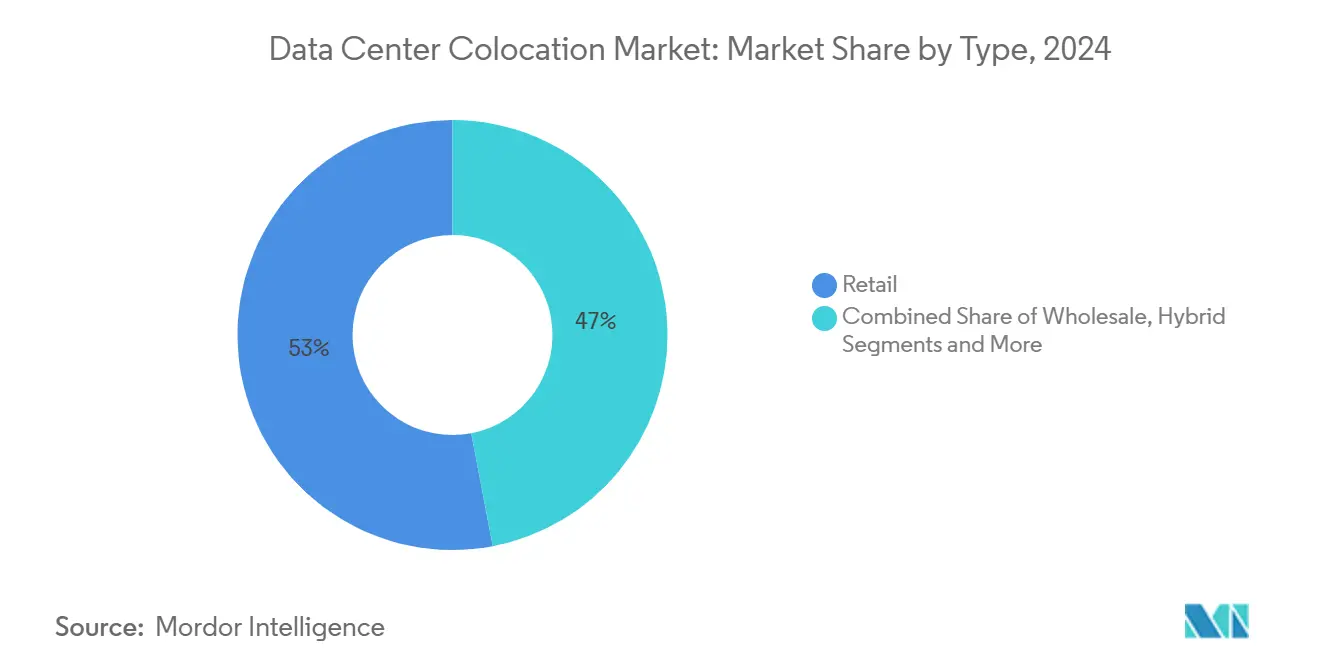
Note: Segment shares of all individual segments available upon report purchase
By Tier Standard: Tier III Leadership with Tier IV Acceleration
Tier III facilities held 56% of the data center colocation market size in 2024 because they balance redundancy with cost efficiency for most enterprise workloads. Financial trading, AI training, and life-safety applications, however, require the 99.995% uptime of Tier IV, driving an 18.9% CAGR forecast for that class through 2030. The architectural shift includes tri-mode UPS configurations, 2N+1 cooling topologies, and predictive-maintenance analytics that pre-empt failures. Hyperscale tenants often sign anchor leases that justify the higher capital intensity, improving the return profile for operators.
Regulators in finance and healthcare now incorporate uptime standards into licensing, effectively hard-coding Tier III as the minimum acceptable standard while rewarding Tier IV with accelerated vendor-approval cycles. This compliance halo inflates perceived value, allowing operators to secure longer contract terms and higher recurring revenue per square foot. As more AI workloads transition from R&D to production, expect Tier IV adoption to expand beyond its high-performance niche, underpinning steady share gains in the data center colocation market.
By Data Center Size: Large Enterprises Lead, Hyperscale Accelerates
Large-enterprise deployments generated 60% of 2024 demand as corporations re-architected around hybrid cloud, but hyperscale customers are pacing future growth at a 20.2% CAGR. A single generative-AI training cluster may now require contiguous blocks of 10 MW, prompting multi-building campus plans that can scale to 300 MW on day-one land banks. Providers such as Vantage Data Centers allocate separate sub-nets, security perimeters, and utility service entrances within the same campus to serve both hyperscale and enterprise tenants concurrently.
Massive and mega-scale builds offer operators cost efficiencies in substation hookups, fiber backhaul, and staff overhead. However, they also demand advanced project-management skill sets, including coordinated GPU supply-chain logistics and water-recycling systems to comply with drought-zone regulations. As hyperscalers seek colocation sites to bridge build-time gaps between owned campuses, this subsegment injects durable volume into the data center colocation market, elevating average contract sizes and lengthening revenue visibility.
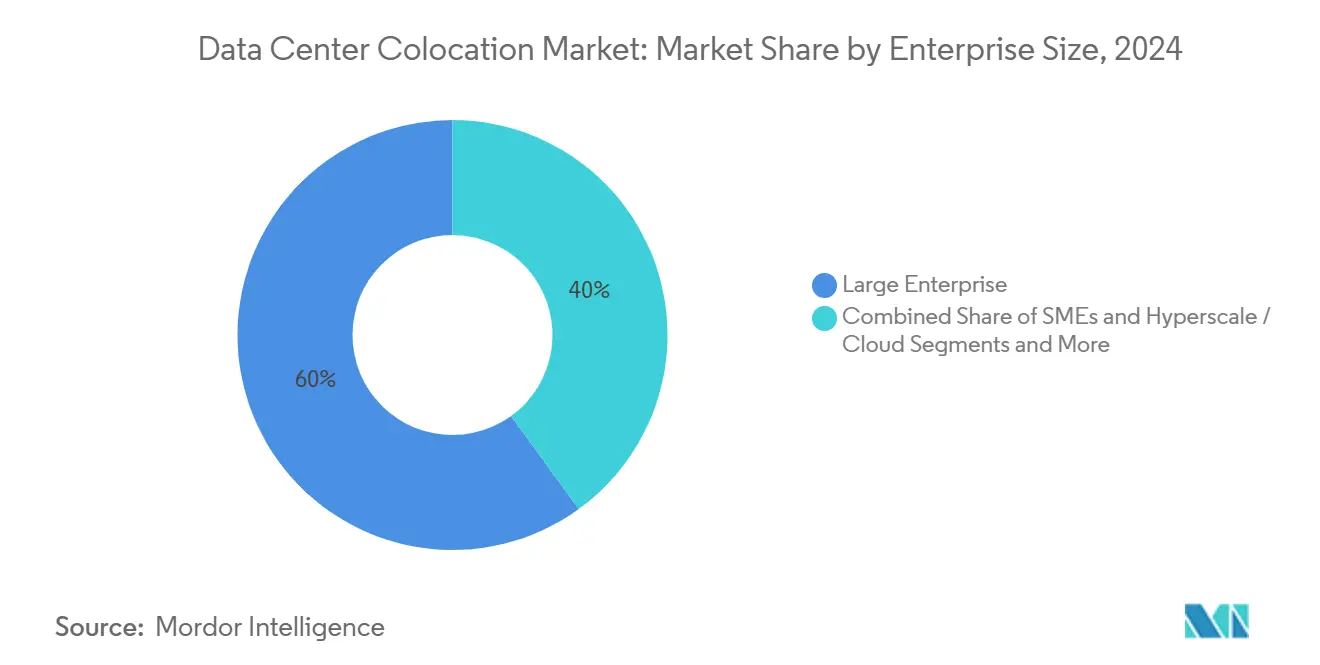
Note: Segment shares of all individual segments available upon report purchase
By End-User Industry: IT and Telecom Dominance, Healthcare Acceleration
IT and Telecom maintained a 27% share in 2024 because network operators and cloud platforms require carrier-hotel proximity and route diversity. Healthcare & Life Sciences, advancing at a 19% CAGR, is the fastest-growing customer cohort thanks to AI-driven diagnostics, genomic sequencing, and telehealth platforms. Hospitals now archive petabytes of imaging data under HIPAA, demanding encryption-at-rest and chain-of-custody controls that proven colocation operators can supply.
Manufacturing and Industrial IoT workloads are likewise expanding, but at lower absolute volume, relying on edge colocation nodes that integrate 5G radio, OT security, and real-time analytics. BFSI remains a bedrock tenant base, anchored by clearing houses and trading exchanges that refuse any lapse in transactional integrity. The widening range of use cases reinforces the data center colocation market as the core infrastructure layer underpinning nearly every digital-transformation agenda.
Geography Analysis
North America retained 40.36% demand in 2024, North America remains the largest revenue contributor thanks to decades of dark-fiber build-out, dense internet-exchange fabrics, and a mature hyperscale footprint that underpins cloud GDP. Power moratoriums in Northern Virginia and Silicon Valley, however, are steering new demand to Phoenix, Columbus, and Montréal, where utilities can still green-light 100 MW blocks inside 24 months. Local governments in these secondary hubs court developers with tax holidays and expedited permitting, tempering the land-scarcity issues dogging legacy metros.
Asia–Pacific is the fastest mover, Asia-Pacific is forecast to post a 25.90% CAGR through 2030. China’s digital-public-infrastructure drive, India’s commerce-cloud adoption, and Japan’s stringent data-residency amendments are all piling megawatt orders into regional pipelines. Singapore has reinstated a constrained build quota, funneling spill-over demand to Johor and Batam. Meanwhile, Australia, Indonesia and the Philippines are receiving first-time hyperscale commitments, positioning the bloc to outpace every other continent in incremental capacity through 2030.
Europe, South America and the Middle East-Africa corridor form the third growth tier. Frankfurt, Dublin and Madrid handle continental overflow as Amsterdam imposes stricter energy-efficiency hurdles. São Paulo is emerging as a southern-hemisphere hub, whereas Riyadh is leveraging sovereign capital to erect new digital corridors linked to Vision 2030 goals. Across all regions, renewable accessibility and streamlined grid interconnections are decisive site-selection filters, making wind-rich Patagonia and solar-dense Emirates unexpectedly attractive for the next wave of builds.
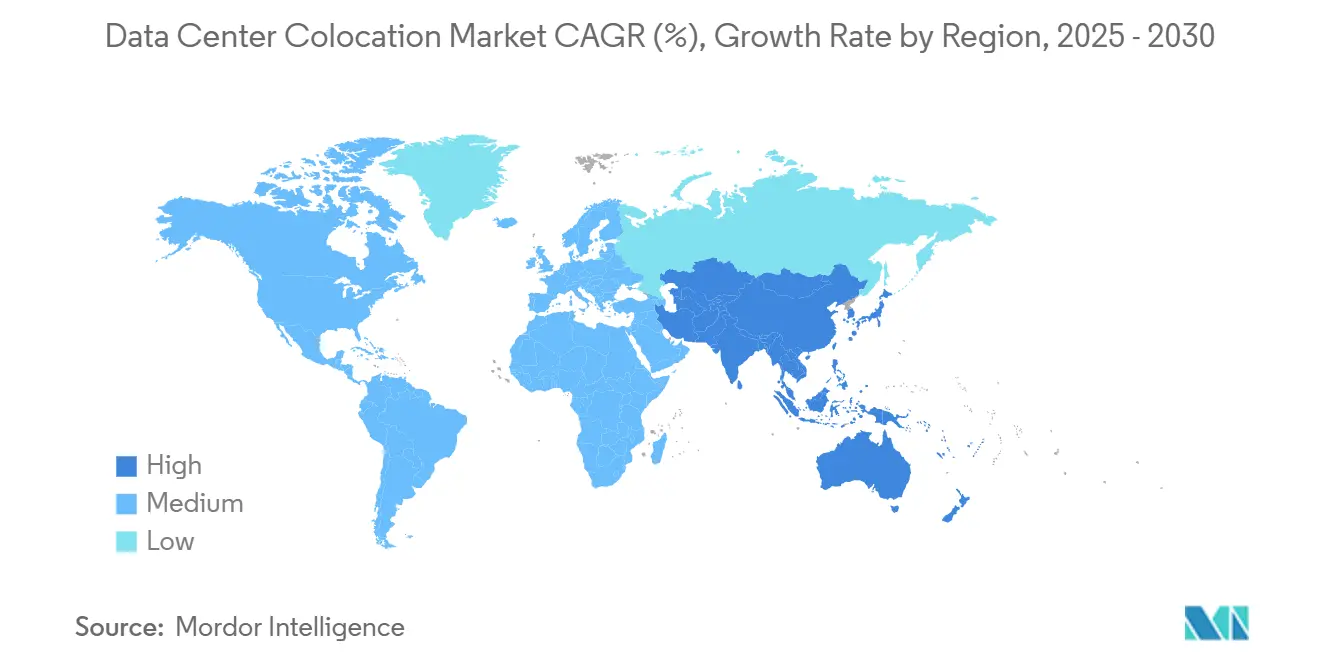
Competitive Landscape
The top 15 operators collectively control roughly half of global leased power, with Equinix, Digital Realty and China Telecom occupying the first three slots. Equinix alone claims an 11% global share and continues to layer software-defined interconnection atop its campus model. Digital Realty has sharpened its focus on multi-tenant wholesale halls following its Interxion integration, while China Telecom leverages domestic fiber dominance to expand outside Greater China.
Consolidation set new records in 2024 as private-equity sponsors closed USD 40 billion worth of mergers and carve-outs, a figure likely to be eclipsed again in 2025. Blackstone’s purchase of AirTrunk and KKR’s interest in Europe’s Global Switch underscore a shift toward infrastructure-fund ownership models that prize 20-year power-purchase annuities over transient technology bets. Competitive wedges now center on liquid-cool enablement, sovereign-AI accreditation and guaranteed carbon-free energy portfolios. Regional specialists are responding by forging utility joint ventures, signing small-modular-reactor MOUs or leasing entire solar farms to stay in the hunt.
Data Center Colocation Industry Leaders
-
Equinix Inc.
-
Digital Realty Trust Inc.
-
NTT Global Data Centers
-
CyrusOne Inc.
-
CoreSite Realty Corp.
- *Disclaimer: Major Players sorted in no particular order
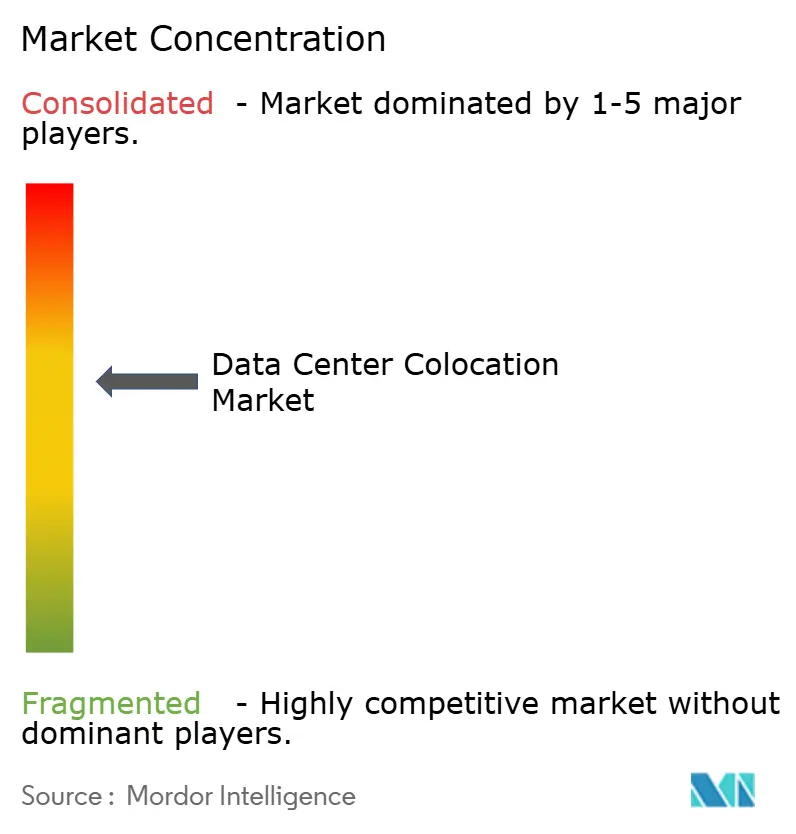
Recent Industry Developments
- February 2025: CapitaLand Investment unveiled a USD 700 million, 50 MW Osaka project aimed at hyperscale tenants.
- January 2025: Indosat Ooredoo Hutchison and BDx Indonesia agreed to co-develop new Indonesian data centers to back the nation’s digital-economy roadmap.
- December 2024: Iliad Group and InfraVia formed a pan-European hyperscale platform to accelerate regional cloud growth.
- September 2024: Princeton Digital Group purchased Yahoo’s SG3 Singapore site, boosting its APAC hyperscale footprint.
Global Data Center Colocation Market Report Scope
Colocation is when organizations place their own servers and other essential computing hardware for data storage in space rented in a physical data center owned and/or operated by a third party. Typically, colocation services include the building in which everything is housed, as well as networking, physical security, redundant power and redundant cooling components, which then support the servers and storage provided by the customer.
The data center colocation market is segmented by type (retail, wholesale, hybrid), by tier (tier 1 and 2, tier 3, tier 4), by enterprises (SMEs, large enterprises), by end-users (BFSI, IT and telecom, e-commerce, government, manufacturing, media and entertainment, other end-users), by geography (North America, Europe, Asia-Pacific, Latin America, Middle East and Africa). The market sizes and forecasts are provided in terms of value (USD) for all the above segments.
| Retail |
| Wholesale |
| Tier I & II |
| Tier III |
| Tier IV |
| Small |
| Medium |
| Large |
| Massive |
| Mega |
| BFSI |
| IT and Telecom |
| E-commerce and Retail |
| Government and Defense |
| Manufacturing and Industrial IoT |
| Media and Entertainment |
| Healthcare and Life Sciences |
| Energy and Utilities |
| North America | United States | |
| Canada | ||
| Mexico | ||
| South America | Brazil | |
| Argentina | ||
| Rest of South America | ||
| Europe | United Kingdom | |
| Germany | ||
| France | ||
| Italy | ||
| Spain | ||
| Russia | ||
| Rest of Europe | ||
| Asia-Pacific | China | |
| Japan | ||
| India | ||
| South Korea | ||
| Australia and New Zealand | ||
| Rest of Asia-Pacific | ||
| Middle East and Africa | Middle East | Saudi Arabia |
| UAE | ||
| Turkey | ||
| Rest of Middle East | ||
| Africa | South Africa | |
| Nigeria | ||
| Kenya | ||
| Rest of Africa | ||
| By Colocation Type | Retail | ||
| Wholesale | |||
| By Tier Standard | Tier I & II | ||
| Tier III | |||
| Tier IV | |||
| By Data Center Size | Small | ||
| Medium | |||
| Large | |||
| Massive | |||
| Mega | |||
| By End-user Industry | BFSI | ||
| IT and Telecom | |||
| E-commerce and Retail | |||
| Government and Defense | |||
| Manufacturing and Industrial IoT | |||
| Media and Entertainment | |||
| Healthcare and Life Sciences | |||
| Energy and Utilities | |||
| By Geography | North America | United States | |
| Canada | |||
| Mexico | |||
| South America | Brazil | ||
| Argentina | |||
| Rest of South America | |||
| Europe | United Kingdom | ||
| Germany | |||
| France | |||
| Italy | |||
| Spain | |||
| Russia | |||
| Rest of Europe | |||
| Asia-Pacific | China | ||
| Japan | |||
| India | |||
| South Korea | |||
| Australia and New Zealand | |||
| Rest of Asia-Pacific | |||
| Middle East and Africa | Middle East | Saudi Arabia | |
| UAE | |||
| Turkey | |||
| Rest of Middle East | |||
| Africa | South Africa | ||
| Nigeria | |||
| Kenya | |||
| Rest of Africa | |||
Key Questions Answered in the Report
What is the expected value of the global data center colocation market in 2031?
The market is forecast to reach USD 295.12 billion by 2031, expanding at an 18.63% CAGR from 2025.
Why are hyperscale cloud providers driving wholesale colocation demand?
Hyperscalers lease multi-megawatt blocks that require dedicated power and cooling, favoring wholesale halls for their scale economics and 15-year contract terms.
How are data-sovereignty regulations influencing facility location decisions?
Laws compelling localized storage push enterprises to place workloads inside in-country colocation sites, spurring new builds in Europe, APAC and emerging markets.
What cooling technologies are gaining traction for AI workloads?
Direct-to-chip and immersion liquid cooling are replacing traditional air systems to support rack densities up to 100 kW.
Page last updated on:
